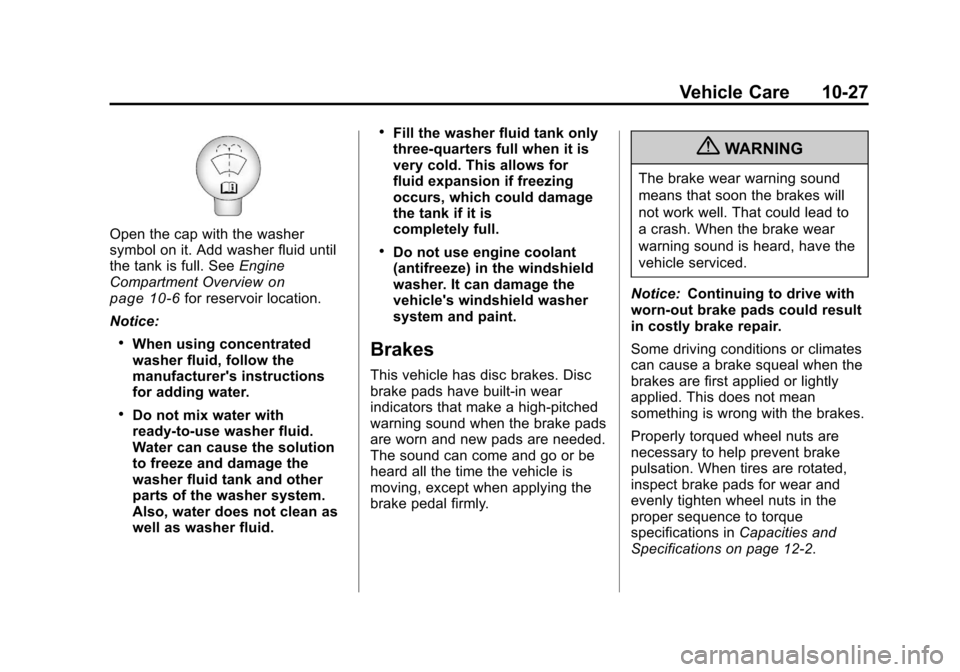engine coolant CADILLAC CTS 2011 2.G User Guide
[x] Cancel search | Manufacturer: CADILLAC, Model Year: 2011, Model line: CTS, Model: CADILLAC CTS 2011 2.GPages: 496, PDF Size: 7.71 MB
Page 325 of 496

Black plate (7,1)Cadillac CTS/CTS-V Owner Manual - 2011
Vehicle Care 10-7
A. Windshield Washer FluidReservoir. See Washer Fluidon
page 10‑26.
B. Engine Compartment Fuse
Block (CTS Coupe and Sedan)
on page 10‑42orEngine
Compartment Fuse Block (CTS
V Coupe and Sedan)
on
page 10‑46or Engine
Compartment Fuse Block (CTS
Wagon)
on page 10‑50or
Engine Compartment Fuse
Block (CTS V Wagon)
on
page 10‑54.
C. Remote Positive (+) Terminal. See Jump Starting
on
page 10‑112. D. Remote Negative (−) Terminal.
See Jump Starting
on
page 10‑112.
E. Passenger Compartment Air Filter. See Passenger
Compartment Air Filter
on
page 8‑6.
F. Engine Cooling Fan (Out of View). See Cooling System
on
page 10‑19.
G. Power Steering Fluid Reservoir (Under Engine Cover). See
Power Steering Fluid
on
page 10‑26.
H. Engine Oil Fill Cap. See Engine
Oil on page 10‑11. I. Engine Oil Dipstick (Out of
View). See Engine Oil
on
page 10‑11.
J. Hydraulic Clutch Reservoir (If Equipped) (Not Shown). See
Hydraulic Clutch on page 10‑15.
K. Brake Master Cylinder Reservoir (Out of View). See
Brakes on page 10‑27.
L. Engine Coolant Surge Tank and Pressure Cap. See Engine
Coolant on page 10‑19.
M. Engine Air Cleaner/Filter
on
page 10‑16.
Page 327 of 496

Black plate (9,1)Cadillac CTS/CTS-V Owner Manual - 2011
Vehicle Care 10-9
A. Windshield Washer FluidReservoir. See Washer Fluidon
page 10‑26.
B. Engine Compartment Fuse
Block (CTS Coupe and Sedan)
on page 10‑42orEngine
Compartment Fuse Block (CTS
V Coupe and Sedan)
on
page 10‑46or Engine
Compartment Fuse Block (CTS
Wagon)
on page 10‑50or
Engine Compartment Fuse
Block (CTS V Wagon)
on
page 10‑54.
C. Remote Positive (+) Terminal. See Jump Starting
on
page 10‑112. D. Remote Negative (−) Terminal.
See Jump Starting
on
page 10‑112.
E. Engine Oil Fill Cap (Out of View). See Engine Oil
on
page 10‑11.
F. Engine Oil Dipstick. See Engine
Oil on page 10‑11.
G. Passenger Compartment Air Filter. See Passenger
Compartment Air Filter
on
page 8‑6.
H. Intercooler System Pressure Cap. See Cooling System
on
page 10‑19.
I. Engine Cooling Fans (Out of View). See Cooling System
on
page 10‑19. J. Hydraulic Clutch Reservoir
(If Equipped) (Not Shown). See
Hydraulic Clutch on page 10‑15.
K. Brake Master Cylinder Reservoir. See Brakes
on
page 10‑27.
L. Engine Coolant Surge Tank and Pressure Cap. See Engine
Coolant on page 10‑19.
M. Power Steering Fluid Reservoir (Under Engine Cover). See
Power Steering Fluid
on
page 10‑26.
N. Engine Air Cleaner/Filter
on
page 10‑16.
Page 337 of 496

Black plate (19,1)Cadillac CTS/CTS-V Owner Manual - 2011
Vehicle Care 10-19
Cooling System
The cooling system allows the
engine to maintain the correct
working temperature.
When you decide it is safe to lift the
hood, here is what you will see:
A. Electric Engine Cooling Fan(s)(Out of View)
B. Coolant Surge Tank and Pressure Cap
{WARNING
An electric engine cooling fan
under the hood can start up even
when the engine is not running
and can cause injury. Keep
hands, clothing, and tools away
from any underhood electric fan.
{WARNING
Heater and radiator hoses, and
other engine parts, can be very
hot. Do not touch them. If you do,
you can be burned.
Do not run the engine if there is a
leak. If you run the engine, it
could lose all coolant. That could
cause an engine fire, and you
could be burned. Get any leak
fixed before you drive the vehicle.
Notice: Using coolant other than
DEX-COOL
®can cause premature
engine, heater core, or radiator
corrosion. In addition, the engine coolant could require changing
sooner, at 50 000 km
(30,000 miles) or 24 months,
whichever occurs first. Any
repairs would not be covered by
the vehicle warranty. Always use
DEX-COOL
®(silicate-free) coolant
in the vehicle.
Engine Coolant
The cooling system in the vehicle
for all engines and the intercooler is
filled with DEX-COOL
®. This coolant
is designed to remain in the vehicle
for five years or 240 000 km
(150,000 miles), whichever occurs
first.
The following explains the cooling
system and how to check and add
coolant when it is low. If there is a
problem with engine overheating,
see Engine Overheating
on
page 10‑24.
Page 338 of 496

Black plate (20,1)Cadillac CTS/CTS-V Owner Manual - 2011
10-20 Vehicle Care
What to Use
{WARNING
Adding only plain water to the
cooling system can be
dangerous. Plain water, or some
other liquid such as alcohol, can
boil before the proper coolant
mixture will. The vehicle's coolant
warning system is set for the
proper coolant mixture. With plain
water or the wrong mixture, the
engine could get too hot but you
would not get the overheat
warning. The engine could catch
fire and you or others could be
burned. Use a 50/50 mixture of
clean, drinkable water and
DEX-COOL
®coolant.Use a 50/50 mixture of clean,
drinkable water and DEX-COOL
®
coolant. If using this mixture,
nothing else needs to be added.
This mixture:
.Gives freezing protection down
to
−37°C (−34°F), outside
temperature.
.Gives boiling protection up to
129°C (265°F), engine
temperature.
.Protects against rust and
corrosion.
.Will not damage aluminum parts.
.Helps keep the proper engine
temperature.
Notice: If an improper coolant
mixture is used, the engine could
overheat and be badly damaged.
The repair cost would not be
covered by the vehicle warranty.
Too much water in the mixture
can freeze and crack the engine,
radiator, heater core, and other
parts.
Checking Coolant
The vehicle must be on a level
surface when checking the coolant
level.
The engine coolant reservoir is
located in the engine compartment
on the driver side of the vehicle.
See Engine Compartment Overview
on page 10‑6.
Check to see if coolant is visible in
the surge tank. If the coolant inside
the surge tank is boiling, do not do
anything else until it cools down.
If coolant is visible but the coolant
level is not at or above the FULL
COLD mark, add a 50/50 mixture of
clean, drinkable water and
DEX-COOL
®coolant at the coolant
surge tank, but be sure the cooling
system is cool before this is done.
If the engine is warm or hot, the
coolant level should be at or above
the FROID/FULL COLD line on the
side of the coolant surge tank. If the
engine is cold, the coolant level
should be near the FROID/FULL
Page 339 of 496

Black plate (21,1)Cadillac CTS/CTS-V Owner Manual - 2011
Vehicle Care 10-21
COLD line on the side of the coolant
surge tank. If it is not, there could
be a leak in the cooling system.
How to Add Coolant to the
Surge Tank
{WARNING
You can be burned if you spill
coolant on hot engine parts.
Coolant contains ethylene glycol
and it will burn if the engine parts
are hot enough. Do not spill
coolant on a hot engine.
Notice: This vehicle has a
specific coolant fill procedure.
Failure to follow this procedure
could cause the engine to
overheat and be severely
damaged.
{WARNING
An electric engine cooling fan
under the hood can start up even
when the engine is not running
and can cause injury. Keep
hands, clothing, and tools away
from any underhood electric fan.
{WARNING
Steam and scalding liquids from a
hot cooling system can blow out
and burn you badly. They are
under pressure, and if you turn
the surge tank pressure
cap —even a little —they can
come out at high speed. Never
turn the cap when the cooling
system, including the surge tank
pressure cap, is hot. Wait for the
cooling system and surge tank
pressure cap to cool if you ever
have to turn the pressure cap. If coolant is needed, add the proper
DEX-COOL
®coolant mixture at the
coolant surge tank.
If no coolant is visible in the surge
tank, add coolant as follows:
1. Remove the coolant surge tank pressure cap when the cooling
system, including the coolant
surge tank pressure cap and
upper radiator hose, is no longer
hot. Turn the pressure cap
slowly counterclockwise about
one-quarter turn and then stop.
If you hear a hiss, wait for that to
stop. A hiss means there is still
some pressure left.
Page 340 of 496

Black plate (22,1)Cadillac CTS/CTS-V Owner Manual - 2011
10-22 Vehicle Care
2. Then keep turning the pressurecap slowly and remove it.3. Fill the coolant surge tank withthe proper mixture, to slightly
above the FROID/FULL COLD
line on the side of the coolant
surge tank.
4. With the coolant surge tank pressure cap off, start the
engine and let it run until you
can feel the upper radiator hose
getting hot. The upper radiator
hose is the top hose coming out
of the radiator, on the passenger
side of the vehicle. Watch out for
the engine cooling fans. By this time, the coolant level
inside the coolant surge tank
may be lower. If the level is
lower, add more of the proper
mixture to the coolant surge tank
until the level reaches the
FROID/FULL COLD line on the
side of the coolant surge tank.
5. Then replace the pressure cap. Be sure the pressure cap is
hand-tight and fully seated.
Notice: If the pressure cap is not
tightly installed, coolant loss and
possible engine damage may
occur. Be sure the cap is properly
and tightly secured.
Recheck the coolant level in the
bottle next time you use your
vehicle to ensure the system is full
when cold.
Page 341 of 496

Black plate (23,1)Cadillac CTS/CTS-V Owner Manual - 2011
Vehicle Care 10-23
Checking Coolant in the
Intercooler System (CTS-V)
The vehicle must be on a level
surface when checking the coolant
level.
The super charged engine
intercooler coolant fill neck is
located in the engine compartment
on the passenger side of the
vehicle. SeeEngine Compartment
Overview on page 10‑6.
On the coolant fill neck, there is a
cold fill region between the two
horizontal lines shown.
Check to see if coolant is visible in
the coolant fill neck. If the coolant is
not visible or below the cold fill
region in the fill neck, add a
50/50 mixture of clean, drinkable
water and DEX-COOL
®coolant at
the coolant fill bottle, but be sure the
cooling system is cool before this
is done.
Adding Coolant to the
Intercooler System
Coolant (CTS-V)
1. Remove the intercooler system
pressure cap when the
intercooler system hoses are no
longer hot. Turn the pressure
cap slowly counterclockwise
about one-quarter of a turn.
If you hear a hiss, wait for that to
stop. This allows any pressure
still left to be vented. 2. Then keep turning the pressure
cap slowly and remove it.
3. Add the proper DEX-COOL
®
coolant mixture to the fill neck
until the coolant is within the
cold fill region.
With the intercooler system
pressure cap off, start the
engine and let it run for a couple
of minutes. Then turn the engine
off. By this time, the coolant
level inside the fill neck may be
lower. If the level drops where
coolant is no longer within the
cold fill region of the fill neck
with the engine off, add more of
the DEX-COOL
®coolant mixture
to the fill neck until the level is
again visible in the cold fill
region.
Page 342 of 496

Black plate (24,1)Cadillac CTS/CTS-V Owner Manual - 2011
10-24 Vehicle Care
4. Then replace the pressure cap.Be sure the pressure cap is
hand-tight and fully seated.
Notice: If the pressure cap is not
tightly installed, coolant loss and
possible engine damage may
occur. Be sure the cap is properly
and tightly secured.
If the coolant is not at the proper
level when the system cools down
again, see your dealer.
Engine Overheating
The vehicle has several indicators
to warn of engine overheating.
There are two engine hot messages
that may be displayed in the Driver
Information Center (DIC). See
Engine Cooling System Messages
on page 5‑35for more information.
You may decide not to lift the hood
when one of these warnings appear,
but get service help right away. See
Roadside Service on page 13‑7. If you do decide to lift the hood,
make sure the vehicle is parked on
a level surface.
Then check to see if the engine
cooling fans are running. If the
engine is overheating, the fan(s)
should be running. If they are not,
do not continue to run the engine
and have the vehicle serviced.
Notice:
Engine damage from
running the engine without
coolant is not covered by the
warranty.
Notice: If the engine catches fire
because of being driven with no
coolant, your vehicle can be
badly damaged. The costly
repairs would not be covered by
the vehicle warranty.
If Steam Is Coming from the
Engine Compartment
{WARNING
Steam from an overheated engine
can burn you badly, even if you
just open the hood. Stay away
from the engine if you see or hear
steam coming from it. Just turn it
off and get everyone away from
the vehicle until it cools down.
Wait until there is no sign of
steam or coolant before you open
the hood.
If you keep driving when your
engine is overheated, the liquids
in it can catch fire. You or others
could be badly burned. Stop your
engine if it overheats, and get out
of the vehicle until the engine
is cool.
Page 345 of 496

Black plate (27,1)Cadillac CTS/CTS-V Owner Manual - 2011
Vehicle Care 10-27
Open the cap with the washer
symbol on it. Add washer fluid until
the tank is full. SeeEngine
Compartment Overview
on
page 10‑6for reservoir location.
Notice:
.When using concentrated
washer fluid, follow the
manufacturer's instructions
for adding water.
.Do not mix water with
ready-to-use washer fluid.
Water can cause the solution
to freeze and damage the
washer fluid tank and other
parts of the washer system.
Also, water does not clean as
well as washer fluid.
.Fill the washer fluid tank only
three-quarters full when it is
very cold. This allows for
fluid expansion if freezing
occurs, which could damage
the tank if it is
completely full.
.Do not use engine coolant
(antifreeze) in the windshield
washer. It can damage the
vehicle's windshield washer
system and paint.
Brakes
This vehicle has disc brakes. Disc
brake pads have built-in wear
indicators that make a high-pitched
warning sound when the brake pads
are worn and new pads are needed.
The sound can come and go or be
heard all the time the vehicle is
moving, except when applying the
brake pedal firmly.
{WARNING
The brake wear warning sound
means that soon the brakes will
not work well. That could lead to
a crash. When the brake wear
warning sound is heard, have the
vehicle serviced.
Notice: Continuing to drive with
worn-out brake pads could result
in costly brake repair.
Some driving conditions or climates
can cause a brake squeal when the
brakes are first applied or lightly
applied. This does not mean
something is wrong with the brakes.
Properly torqued wheel nuts are
necessary to help prevent brake
pulsation. When tires are rotated,
inspect brake pads for wear and
evenly tighten wheel nuts in the
proper sequence to torque
specifications in Capacities and
Specifications on page 12‑2.
Page 449 of 496

Black plate (3,1)Cadillac CTS/CTS-V Owner Manual - 2011
Service and Maintenance 11-3
Scheduled
Maintenance
When the Change Engine Oil
Soon Message Displays
Change engine oil and filter. See
Engine Oilon page 10‑11.An
Emission Control Service.
When the “Change Engine Oil
Soon” message displays, service is
required for the vehicle as soon as
possible, within the next 1 000 km/
600 miles. If driving under the best
conditions, the engine oil life system
might not indicate the need for
vehicle service for more than a year.
The engine oil and filter must be
changed at least once a year and
the oil life system must be reset.
Your dealer has trained service
technicians who will perform this
work and reset the system. If the
engine oil life system is reset
accidentally, service the vehicle
within 5 000 km/3,000 miles since
the last service. Reset the oil life system whenever the oil is changed.
See
Engine Oil Life System
on
page 10‑14.
Every Engine Oil Change
.Change engine oil and filter.
Reset oil life system. See
Engine Oil
on page 10‑11and
Engine Oil Life Systemon
page 10‑14. An Emission Control
Service.
.Engine coolant level check. See
Engine Coolant on page 10‑19.
.Engine cooling system
inspection. Visual inspection of
hoses, pipes, fittings, and
clamps and replacement,
if needed.
.Windshield washer fluid level
check. See Washer Fluidon
page 10‑26.
.Windshield wiper blade
inspection for wear, cracking,
or contamination and windshield
and wiper blade cleaning,
if contaminated. See Exterior
Care
on page 10‑120. Worn or
damaged wiper blade
replacement. See Wiper Blade
Replacement on page 10‑34.
.Tire inflation pressures check.
See Tire Pressure on
page 10‑74.
.Tire wear inspection. See Tire
Inspection on page 10‑80.
.If tire rotation is recommended
for the vehicle, rotate tires if
necessary. See Tire Rotation
on
page 10‑81.
.Fluids visual leak check
(or every 12 months, whichever
occurs first). A leak in any
system must be repaired and the
fluid level checked.